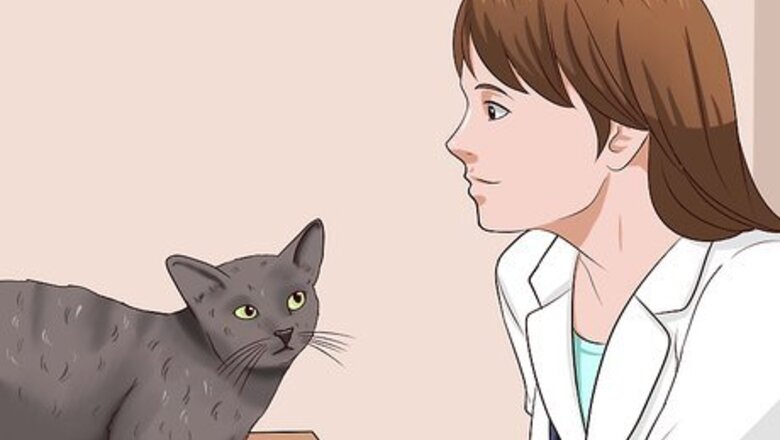
views
X
Research source
But some health conditions, including obesity, chronic illnesses, eye problems, and arthritis, make it difficult for cats to keep their coats clean. You will need to take steps to keep your pet clean whenever he cannot or will not do it himself. The best way to approach this task is to incorporate it into your daily routine. It is far easier to maintain a cat's coat than to deal with a dirty and severely matted cat.
Brushing Your Cat
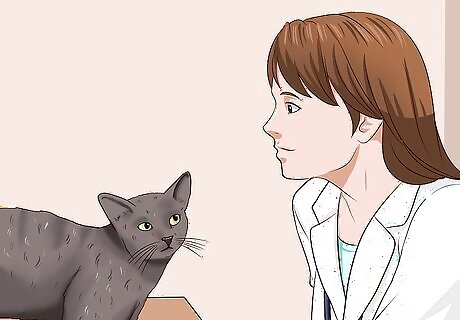
Take your cat to the veterinarian. If your cat is having a hard time with grooming, then your cat may have a medical condition that makes it painful to groom. In this case, addressing the underlying issue will help to make your cat more comfortable and your cat may even start grooming himself again. Treatments might include dental attention for a cat with a sore mouth or pain killing medications for the elderly arthritic. If your cat’s fur is severely matted, then seek the help of a professional to remove the matted fur. It is traumatic to the cat to have large matts removed and it is often kindest to sedate the cat so that he is happily oblivious to the procedure.
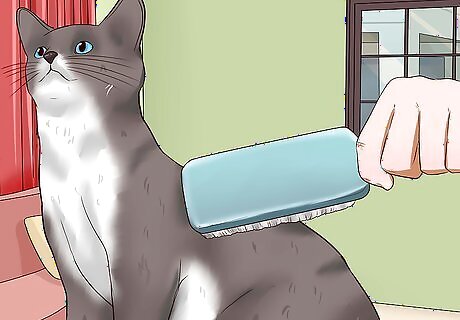
Incorporate brushing into your daily routine. When your cat is not grooming himself as well as he once did, one of the best things you can do is to incorporate regular brushing into your routine. Brushing the cat from head to tail removes loose fur, dirt and other debris and stimulates circulation and sebaceous gland secretions. This helps return shine and luster to the coat and prevents the formation of painful mats, especially in long-haired cats.

Wait until your cat is relaxed before initiating a grooming session. Do not brush your cat while he is agitated. Gently pet your cat and talk soothingly to him. He will respond better to you. If your cat is not used to being groomed then he may resent being brushed. Try to help him understand it is a pleasant experience and keep the first sessions short so that he doesn't lose patience. Try brushing your cat right before you feed him so that he associates being brushed with a food reward afterwards. This may increase his tolerance levels for being brushed. Keep in mind that brushing can be a bonding experience between owner and pet. But if your pet is agitated or stressed, he may start to associate negative feelings with you instead.
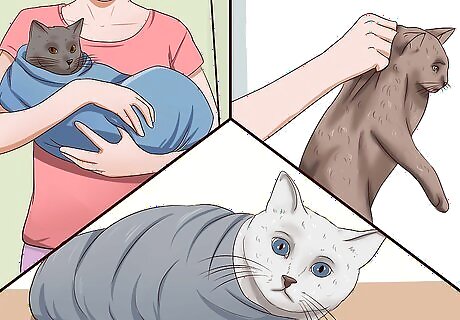
Take steps to protect yourself and keep your cat calm. In some cases you may need to groom your cat right away even if he is unwilling. For example, if you cat has soiled himself, then it might be necessary to groom your cat even if he is agitated. In these cases there are several options to help you calm and control your cat. Use a towel. If it is essential to groom the cat right away and he is agitated, try wrapping him in a towel with only the dirty area left out. Having his eyes covered can help to calm him down. Plus, having his teeth and claws inside the towel will protect your hands from bites and scratches. Hold onto your cat’s neck scruff. Some cats will calm down if you hold onto their scruff, which is the skin on the back of a cat’s neck. When a mother picks her kittens up by the scruff it has a calming effect, and this persists in some adults. However, do not pick the cat up by the scruff, merely grasp a handful of skin over his shoulder and hold it firmly while he rests on a flat surface. Work at a height that is comfortable for you. It might be easier to clean your cat is you put him on a high tabletop or on top of a dryer. This will prevent you from having to bend and strain your back. Help the cat to feel secure by placing a blanket or towel on the table top so that he is less likely to slip and slide around.
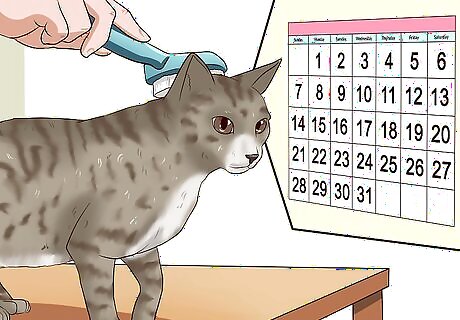
Determine how frequently you should brush your cat. Long-haired cats need to be brushed frequently, preferably on a daily basis. Otherwise, their fur may become matted and dirty. Short-haired cats can be brushed less often, such as a few times per week and as needed.

Be gentle as you brush your cat’s fur. Take your time when brushing your cat so that you do not pull the fur or frighten your cat. Be aware that elderly cats with painful joints and arthritis, can become hissy when you go near their joints. It is all too easy to bang a comb or brush against a bony cat's hips, shoulders, elbows, or knees, and cause pain, so work slowly and carefully over these areas.

Use the brushing session to examine your cat’s skin. Take a few moments as you brush your cat to check his skin for any abnormalities, raw or bare spots, or other problems. If you notice anything abnormal, make sure that you contact your veterinarian as soon as possible. Make sure to check for fleas while combing your cat as well. Part the fur and look for small shiny brown insect about the size of a sesame seed. Check for flea dirt as well. These look like little specks of dirt. If you find something suspicious put the speck on damp cotton wool. If it is flea dirt the moisture will rehydrate the dried blood and you will see an orange halo. Run your fingers over the cat's body to feel for lumps and bumps. If you find a new lump, or an existing lump is growing or seems to bother your cat when you touch it, take your cat to see a vet as soon as possible.

Remove debris with a metal comb. A metal comb can be used to remove debris and other matter from your cat’s fur. It can also help to untangle the coat, which is especially useful for longer-haired cats. Start by combing the hair on your cat’s tummy and legs. Then comb the fur on the back, combing it upward and toward her head. Comb out the tail too.
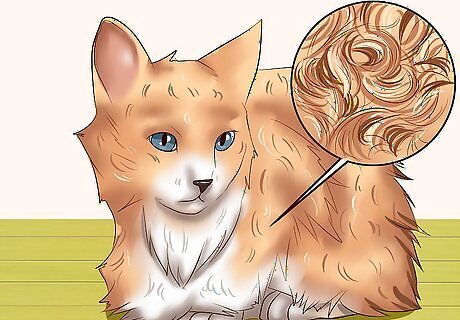
Untangle any knots that you find. If your cat has long hair, take extra care to untangle knots before they become a bigger problem. If you find any knots, gently untangle them. You can use a comb, a mat splitter, or your fingers. No matter what you use, try to hold onto the base of the mat near the skin so that you do not pull on the skin as you work through the mat.

Remove mats you can’t untangle. If you find a mat that you cannot untangle, remove it with clippers rather than scissors to avoid cutting the cat's skin. Cats have very delicate skin underneath their fur. If it gets nicked, your cat might get an infection. In worse cases, your cat may need stitches. If you do not feel comfortable removing the mat yourself, contact a groomer who is experienced with cats or contact your veterinarian. If you do not have clippers, use scissors but with care. The safest method is to slide a comb between the skin and the base of the knot. Then cut above the comb on the knot side. The comb shields the skin and makes it less likely you will nick it. If you cannot get a comb under the knot then this is a job for a professional groomer or the vet tech, and do not attempt it yourself.
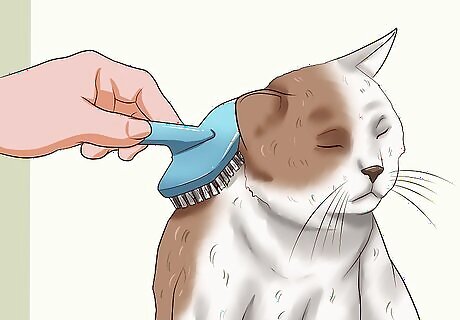
Use a brush to remove loose hair. After combing the coat, use a rubber or bristle brush to remove loose hair. This will grab the last of the loose hair and it will also feel good to your cat. Even short-haired cats need to be brushed, otherwise the hair that they shed can get stuck in their coat.
Cleaning Your Cat’s Face and Ears
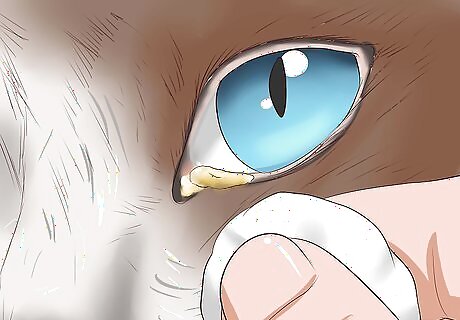
Remove crust from around your cat’s eyes. If your cat has crust in the corners of the eyes or has an eye problem that is causing tearing or other discharge, you will need to clean around the eyes. This will keep the cat comfortable and prevent further irritation. You should also take your cat to the vet to have the discharge looked at. Sometimes cats get colds and other viruses that require some medication to clear them up. Blot tears with a cotton ball or soft cloth. Use a moistened piece of cotton to remove crusted debris or other dried or thick material around the cat's eyes. Make sure to use a separate cloth or cotton ball for each eye to help prevent the spread of infections between the eyes. Avoid using eye washes or drops in the eyes themselves unless directed to do so by a veterinarian.
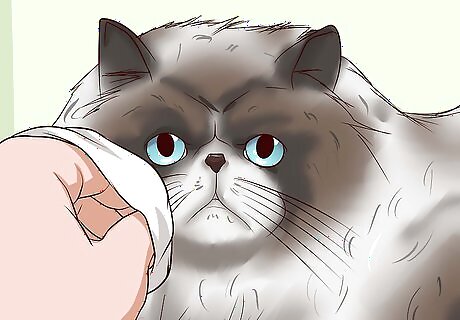
Clean the facial folds. Facial folds are prominent in flat-faced breeds like the Persian and Himalayan. These should be cleaned, especially for cats with chronic eye discharge. Tears and other discharge can build up in these folds and predispose the cat to skin disease. To clean facial folds, use a piece of moistened cotton or a moist soft cloth to gently remove tears and other debris in the area. Make sure to get the skin between the folds as well as the skin on either side. Chronic moisture is a concern here, so make sure to use a damp rather than wet cloth. Gently pat the cleansed area dry after wiping.
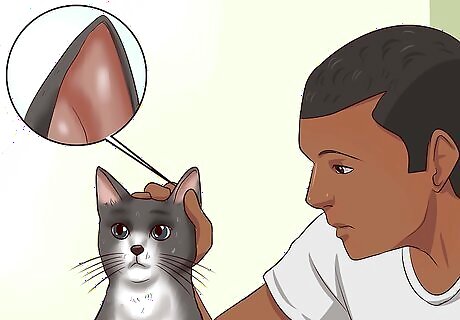
Examine and clean the ears. Take a look at your cat’s ears. They should be pale pink in color, and there shouldn’t be any debris, wax build-up, or odor. If you are in doubt as to whether there is a problem or not, compare one ear with the opposite side - they should both look the same. If one side looks different to the other, then you will know there is an issue. To clean the ears: Ask your vet to recommend a liquid ear cleaner, which is generally available at a pet supply store. Use a small amount of cleaner on a cotton ball. Fold the cat’s ear back and use the cotton ball to wipe away dirt. Do not clean the ear canal, as this can cause trauma and/or infection. Do not put cotton tips down into the ear canal, because if the cat moves suddenly you could damage the ear or cause pain. Never put water down into the ear as this softens the skin and makes ear infections more likely.
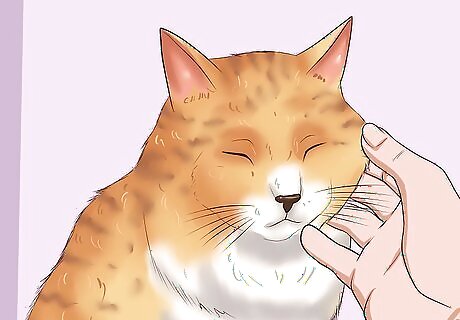
Examine your cat’s face for health problems. While you’re cleaning your cat, this is a good time to examine him for any problems. For example, if your cat has eye discharge, redness of the eyes, is blinking his eyes a lot, has watery eyes, a vet visit is in order. See your vet if the skin in your cat’s facial folds is red, darkened, seems irritated or the cat is losing hair. Your cat’s ears may be irritated if he is scratching them a lot. You might also find evidence of ear mites. Talk with your vet if you have concerns about your cat’s ears.
Cleaning Your Cat’s Behind
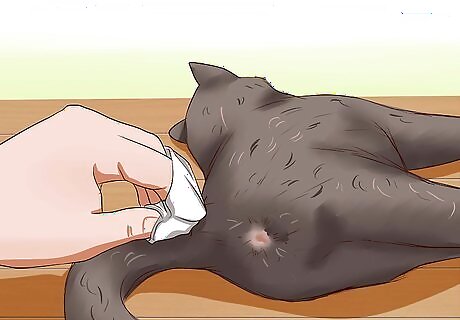
Remove fecal matter from your cat’s fur as soon as you notice it. When you have a cat that cannot or will not groom himself, you should be concerned about feces getting stuck in the fur under the tail. This is especially true in long-haired cats and pets with diarrhea. If stuck fecal matter is not promptly removed, it can mat in the fur and eventually cause skin problems and prevent the cat from defecating normally.

Wear gloves. Slip on a pair of latex or rubber gloves while cleaning feces from your cat’s fur. Cat feces can contain toxoplasmosis, a parasitic condition that is especially dangerous for pregnant women. If you’re pregnant, have your partner clean the cat (and the litter box).
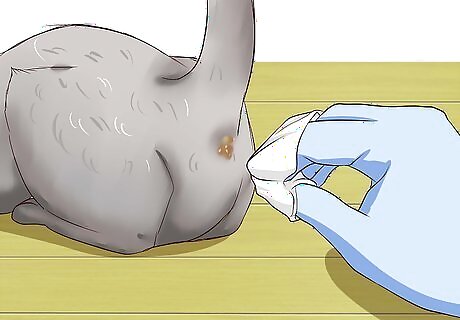
Clean the hind end with a wet paper towel. If the fecal nuggets are dry, try pulling them out of the fur. If this fails then use a dampened paper towel to wipe feces from the cat’s hind end. There are also kitty wipes, which are generally available at pet supply stores. You can use baby wipes, but make sure they are not scented at all. Your cat will lick his fur after you clean him, and if there is any residue from the baby wipes, he will ingest that. Clean the area once a day or as needed.
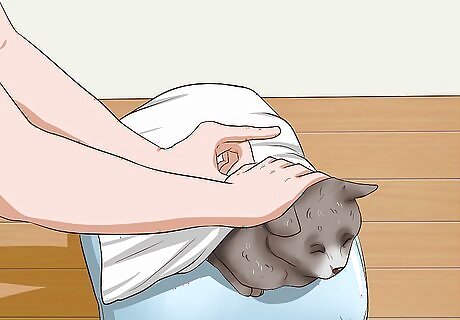
Dry your cat with a towel. Once you have removed the feces, it’s important to dry the area. Leaving your cat wet can lead to further matting of the fur and skin irritation.
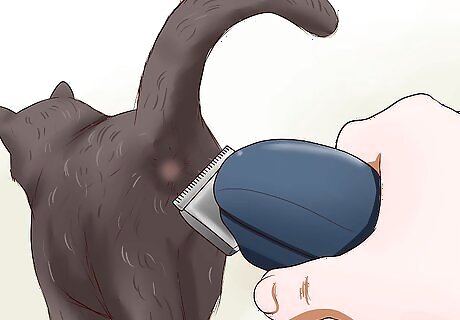
Consider getting your cat’s behind clipped. If you cannot remove the matted feces easily, consider having the hair around the anus clipped to prevent feces from being trapped in the fur. Cat groomers commonly perform this procedure and refer to it as a hygiene clip or sani-clip.
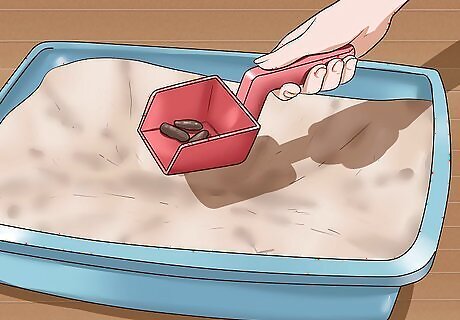
Keep the litter box clean. If your cat’s litter box isn’t clean, he may try to defecate in the corner of the box, getting more feces on his fur. Or, he might try to go elsewhere, which can also increase the chance of getting feces on his fur. Scoop out the litter box every day. Replace the litter every one to three weeks.

Call the vet if you suspect problems. If your cat has open sores in the area or is having problems defecating due to matted fur, take the cat to the veterinarian rather than the groomer. Your cat may need treatment for the sores and any other issues he is dealing with.
Giving Your Cat a Full Bath
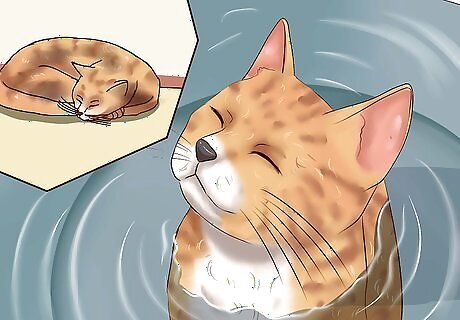
Give your cat a bath only if necessary. Cats rarely need full baths. Regular brushing and spot cleaning are usually sufficient to keep cats clean. If your cat gets into something sticky, rolls around in dirt, has a particularly nasty episode of diarrhea or does something else to foul large areas of his coat, however, you will need to bathe him. If you don’t want to bathe your cat yourself, you can take him to a professional groomer.
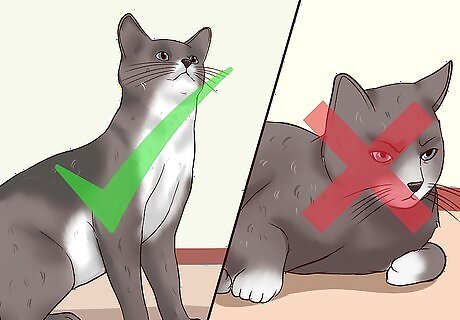
Choose a good time to bathe your cat. Your cat won’t get as stressed in the tub if you choose a time when he is calm and mellow. Try playing with your cat for a while to tire him out and then start the bath. If your cat seems agitated, wait until he calms down before trying to bathe him.
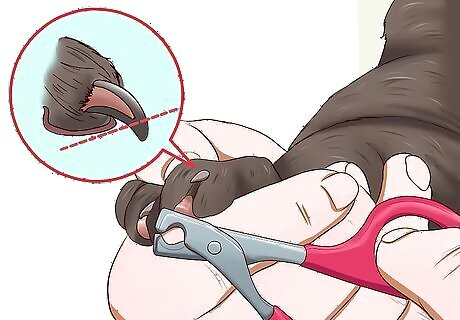
Trim your cat’s claws. Before you get your cat into the tub, you may want to trim his claws. If your cat protests during the bath, you won’t get scratched as much. Make sure that you do not trim them down too far, just trim the ends so that they are not so pointy. If you trim too far down, you may strike the quick, which will be very painful for your cat and may bleed as well. If you are nervous about trimming your cat's nails, you can take your cat to a groomer or to your veterinarian to have them trimmed.

Give your cat a good brushing. Running a brush over your cat will help remove loose hair and debris. It’s important to remove mats as well, since shampoo could get lodged in a mat.
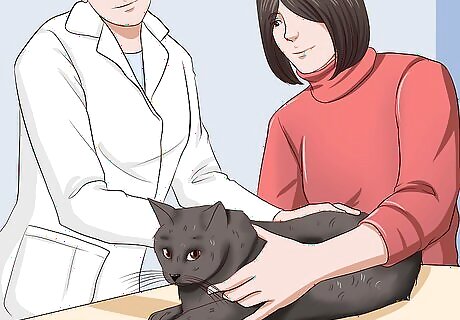
Get someone to help you. Have a helper on hand to restrain the cat or hand you necessary items. Bathing a cat alone is very challenging, so don’t try to do it on your own unless you have no other option.
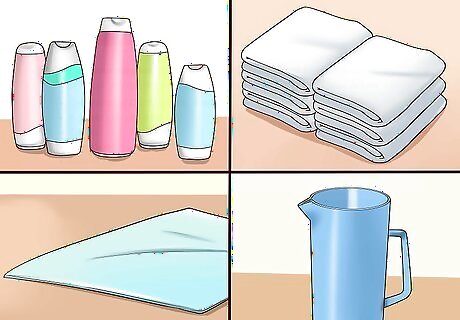
Gather your supplies. Before involving the cat in the process, gather necessary supplies so you are prepared once you get your cat in the tub. These include: Cat shampoo: Don’t use dog shampoo. A plastic cup or pitcher Towels Washcloth Rubber mat
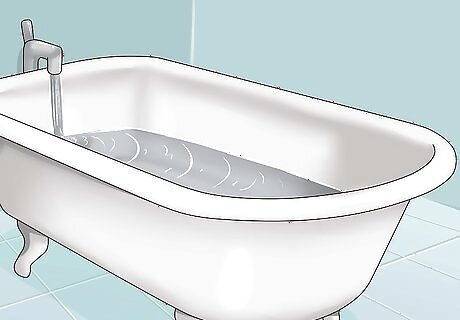
Prepare the tub or sink. You can either bathe your cat in the tub or a sink if your sink is big enough. Place the rubber mat in the sink or tub. This mat will prevent the cat from slipping. Fill the tub with three to four inches of lukewarm water.
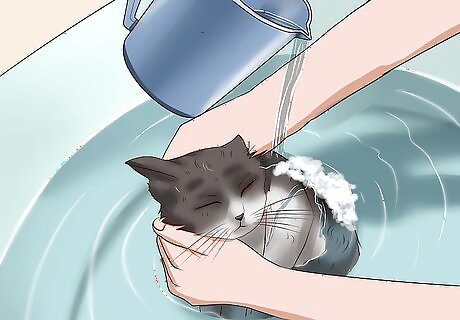
Begin bathing your cat. Place the cat in the tub, and have your friend hold onto the scruff of your cat's neck. Then, use the cup or pitcher to thoroughly wet your cat's fur. Only wet your cat from the neck down and try your best to avoid getting water in your cat's eyes, nose, and ears. Speak soothingly to your cat as you do this to help keep him calm. Reassure him and be gentle.
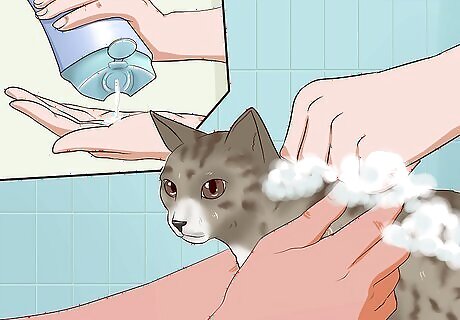
Massage a shampoo solution into your cat's fur. Use a solution of one part cat shampoo and five parts water to wash your cat. Have your friend continue to hold your cat's neck scruff while you mix the solution. Pour the solution over your cat, avoiding the eyes, ears, and nose. Then, use your fingertips to gently massage the shampoo into your cat's fur. If you need to clean around your cat's behind, wear a pair of latex or vinyl gloves.
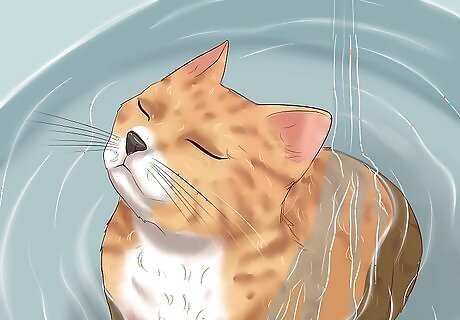
Rinse away the shampoo. Using the pitcher or cup, gently pour warm water over your cat's fur. Again, avoid the eyes, ears, and nose. Make sure that you’ve thoroughly rinsed all of the shampoo residue off of your cat's fur. You may need to use several cupfuls or pitcherfuls to get all of the soap out of your cat's fur.
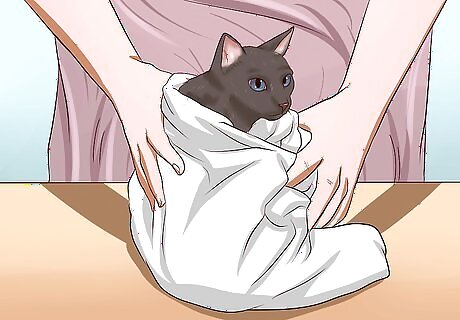
Dry your cat. When you are finished, have your friend gently lift your cat out of the tub and place him onto a towel. Then, wrap another towel around your cat to help him dry off and get warm. Take your cat to a warm room where he can dry off.
Getting Your Cat Professionally Groomed
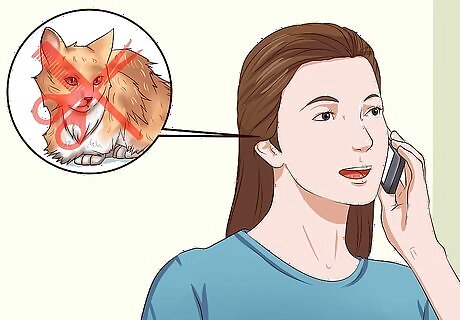
Try professional grooming if you can’t keep up with your cat’s grooming. If you aren’t home a lot or you’re too busy to regularly groom your cat, you might consider taking your kitty to a professional grooming service. Among the services offered by a groomer are: brushing the fur, shaving difficult mats, clipping nails, cleaning ears, and bathing.
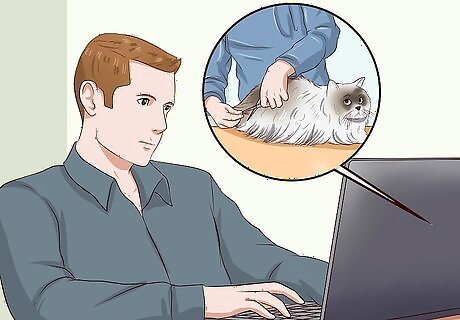
Find a groomer that specializes in cats. Look online or ask for a referral from your veterinarian. Check to see if the groomer is part of the National Cat Groomers Institute of America. This association institutes and maintains standards for cat grooming.
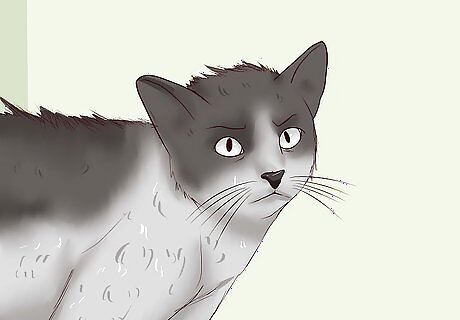
Consider your cat’s stress. You need to balance how much your cat might get stressed out if you take him to a groomer. Consider how well your cat does in the car riding to the groomer. The experience of grooming can be difficult for a cat. But if your cat’s fur is in really bad shape, it might be worth the stress to get him cleaned up.
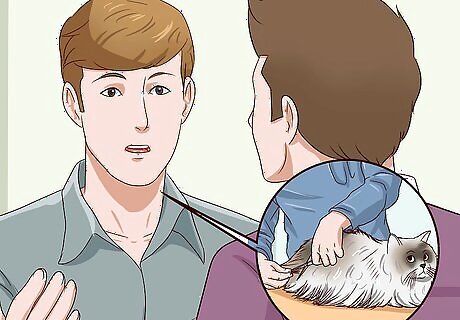
Ask your vet about clipping your cat. If daily brushing and occasional spot cleaning are not sufficient to keep your cat clean, speak to your veterinarian about whether or not clipping your cat’s fur is advisable. Clipping is often not necessary for cats with normal grooming habits or for those that can be easily groomed by their owners. But long-haired cats tend to mat easily. They often object to daily brushing and do not adequately groom themselves. These types of cats may do better if most of their fur is clipped. Depending on the cat's temperament, this procedure may require sedation by a veterinarian.




















Comments
0 comment